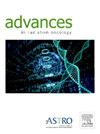预测单发脑转移瘤立体定向放疗后放射性坏死:单变量模型的外部验证和多变量模型的发展
IF 2.7
Q3 ONCOLOGY
引用次数: 0
摘要
目的立体定向放射治疗(SRT)是脑转移瘤(BMs)患者常用且有效的治疗方法。放射性坏死(RN)是SRT的严重并发症,可引起神经系统症状。先前已经建立了正常组织并发症概率(NTCP)模型,以健康脑接受≥12 Gy的体积为基础预测RN的风险。本研究的目的是对该预测模型进行外部验证。方法与材料回顾性分析采用SRT治疗孤立性脑转移的162例患者。采用判别(c -统计)和校正(Brier评分)对所有(无症状和有症状)RN和有症状RN病例的NTCP模型进行评估。采用Kaplan-Meier法测定总生存期。结果中位总生存期为10个月。44例(27%)患者出现无症状或有症状的RN。其中,26例(16%)RN病例出现症状,6个月和12个月后的精算率分别为11%和22%。“任意型RN”与“症状型RN”模型的c统计量相同(0.61)。Brier评分分别为0.201和0.217。单变量logistic回归分析显示,≥12 Gy的健康脑肿瘤体积与有症状的RN存在显著相关。这些效应在多变量分析中并不成立。建立了nomogram并进行了内部验证。结论所测试的NTCP模型在评估SRT后BM患者RN风险方面的准确性不足,无法用于临床实践。我们开发了一种新的多因子nomogram来预测症状性RN。该模型需要外部验证。本文章由计算机程序翻译,如有差异,请以英文原文为准。
Predicting Radionecrosis After Stereotactic Radiation Therapy for Solitary Brain Metastases: External Validation of a Univariable Model and Development of a Multivariable Model
Purpose
Stereotactic radiation therapy (SRT) is a frequently used and effective treatment for patients who received diagnosis for brain metastases (BMs). Radionecrosis (RN) is a severe complication of SRT which may cause neurologic symptoms. A normal tissue complication probability (NTCP) model has previously been established to predict the risk of RN based on the volume of healthy brain receiving ≥12 Gy. The aim of this study is to externally validate this prediction model.
Methods and Materials
A total of 162 patients treated with SRT for solitary BMs were retrospectively included. The NTCP models for all (asymptomatic and symptomatic) RN and symptomatic RN cases were evaluated using discrimination (C-statistic) and calibration (Brier scores). Overall survival was determined using the Kaplan-Meier method.
Results
Median overall survival was 10 months. Asymptomatic or symptomatic RN was found in 44 (27%) of patients. Of these, 26 (16%) RN cases were symptomatic, with actuarial rates of 11% and 22% after 6 and 12 months, respectively. The C-statistics of the “any RN” and the “symptomatic RN” models were identical (0.61). Brier scores were 0.201 and 0.217, respectively. Univariable logistic regression analysis showed a significant correlation between both tumor volume and volume of healthy brain receiving ≥12 Gy with symptomatic RN. These effects did not hold up in the multivariable analysis. A nomogram was established and internally validated.
Conclusions
The accuracy of the tested NTCP models in assessing the risk of RN in patients with BM after SRT was insufficient for clinical practice. A novel multifactorial nomogram was developed to predict symptomatic RN. This model needs to be externally validated.
求助全文
通过发布文献求助,成功后即可免费获取论文全文。
去求助
来源期刊

Advances in Radiation Oncology
Medicine-Radiology, Nuclear Medicine and Imaging
CiteScore
4.60
自引率
4.30%
发文量
208
审稿时长
98 days
期刊介绍:
The purpose of Advances is to provide information for clinicians who use radiation therapy by publishing: Clinical trial reports and reanalyses. Basic science original reports. Manuscripts examining health services research, comparative and cost effectiveness research, and systematic reviews. Case reports documenting unusual problems and solutions. High quality multi and single institutional series, as well as other novel retrospective hypothesis generating series. Timely critical reviews on important topics in radiation oncology, such as side effects. Articles reporting the natural history of disease and patterns of failure, particularly as they relate to treatment volume delineation. Articles on safety and quality in radiation therapy. Essays on clinical experience. Articles on practice transformation in radiation oncology, in particular: Aspects of health policy that may impact the future practice of radiation oncology. How information technology, such as data analytics and systems innovations, will change radiation oncology practice. Articles on imaging as they relate to radiation therapy treatment.
 求助内容:
求助内容: 应助结果提醒方式:
应助结果提醒方式:


